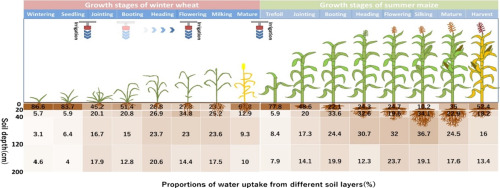Science of the Total Environment ( IF 9.8 ) Pub Date : 2017-11-10 , DOI: 10.1016/j.scitotenv.2017.10.315 Xin Zhao , Fadong Li , Zhipin Ai , Jing Li , Congke Gu

|
Better managing agricultural water resources, which are increasingly stressed by climate change and anthropogenic activities, is difficult, particularly because of variations in water uptake patterns associated with crop type and growth stage. Thus, the stable isotopes δ18O and δ2H were employed to investigate the water uptake patterns of a summer maize (Zea mays L.) and winter wheat (Triticum aestivum L.) rotation system in the North China Plain. Based on the soil water content, soil layers were divided into four groups (0–20 cm, 20–40 cm, 40–120 cm, and 120–200 cm) using a hierarchical cluster analysis. The main soil layer of water uptake for summer maize was from 0–20 cm at the trefoil (77.8%) and jointing (48.6%) stages to 20–40 cm at the booting (33.6%) and heading (32.6%) stages, became 40–120 cm at the silking (32.0%) and milking (36.7%) stages, and then returned to 0–20 cm at the mature (35.0%) and harvest (52.4%) stages. Winter wheat most absorbed water from the 0–20 cm soil water at the wintering (86.6%), seedling (83.7%), jointing (45.2%), booting (51.4%), heading (28.8%), and mature (67.8%) stages, but it was 20–40 cm at the flowering (34.8%) and milking (25.2%) stages. The dry root weight density was positively correlated with the contributions of the water uptake for winter wheat. However, no similar correlation was found in summer maize. Regression analysis indicated that the soil volumetric water content (SVWC) was negatively correlated with the contribution of the water uptake (CWU) for summer maize (CWU = − 0.91 × SVWC + 57.75) and winter wheat (CWU = − 2.03 × SVWC + 92.73). These different responses to water uptake contributions suggested that a traditional irrigation event should be postponed from the booting to flowering stage of winter wheat. This study provides insights into crop water uptake and agricultural water management.
中文翻译:

稳定的同位素证据可确定华北平原典型冬小麦-夏季玉米轮作田中的作物吸水量
由于气候变化和人为活动日益受到越来越多的压力,要更好地管理农业水资源是很困难的,特别是由于与作物类型和生长阶段有关的水吸收模式的变化。因此,稳定的同位素δ 18 O和δ 2 H,分别用于研究水吸收一个夏玉米(图案玉蜀黍L.)和冬小麦(小麦L.)华北平原的旋转系统。根据土壤含水量,使用层次聚类分析将土壤层分为四组(0–20 cm,20–40 cm,40–120 cm和120–200 cm)。夏季玉米的主要吸水层在三叶期为0–20 cm(77.8%)和拔节期(48.6%),在孕穗期(33.6%)和抽穗期(32.6%)为20–40 cm,在抽丝(32.0%)和挤奶(36.7%)阶段变为40–120 cm,然后在成熟(35.0%)和收获(52.4%)阶段返回0–20 cm。越冬时,冬小麦从0-20 cm的土壤中吸收的水分最多(86.6%),幼苗(83.7%),拔节(45.2%),靴子(51.4%),抽穗期(28.8%)和成熟期(67.8%) )阶段,但在开花(34.8%)和挤奶(25.2%)阶段为20–40 cm。干燥根重密度与冬小麦水分吸收的贡献呈正相关。但是,在夏季玉米中未发现类似的相关性。回归分析表明,土壤体积水含量(SVWC)与夏季玉米(CWU = − 0.91×SVWC + 57.75)和冬小麦(CWU = − 2.03×SVWC + 92.73)的吸水量(CWU)呈负相关。 )。对水分吸收贡献的这些不同反应表明,应将传统的灌溉事件从冬小麦的孕穗期推迟到开花期。这项研究提供了对作物水分吸收和农业用水管理的见解。回归分析表明,土壤体积水含量(SVWC)与夏季玉米(CWU = − 0.91×SVWC + 57.75)和冬小麦(CWU = − 2.03×SVWC + 92.73)的吸水量(CWU)呈负相关。 )。对水分吸收贡献的这些不同反应表明,应将传统的灌溉事件从冬小麦的孕穗期推迟到开花期。这项研究提供了对作物水分吸收和农业用水管理的见解。回归分析表明,土壤体积水含量(SVWC)与夏季玉米(CWU = − 0.91×SVWC + 57.75)和冬小麦(CWU = − 2.03×SVWC + 92.73)的吸水量(CWU)呈负相关。 )。对水分吸收贡献的这些不同反应表明,应将传统的灌溉事件从冬小麦的孕穗期推迟到开花期。这项研究提供了对作物水分吸收和农业用水管理的见解。



























 京公网安备 11010802027423号
京公网安备 11010802027423号